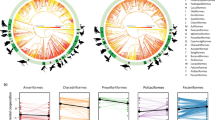Abstract
In many cooperative animal societies, individuals can recognize their relatives and preferentially direct helping behaviors towards them. However, the ability to learn kin recognition cues may be constrained in societies with low relatedness, since group membership alone is not a reliable proxy for kinship. Here, we examine kin discrimination in the greater ani (Crotophaga major), a communally nesting bird in which several unrelated males and females reproduce in a single, shared nest and provide parental care to the mixed clutch of young. Each adult, therefore, is closely related to some nestlings in the clutch and unrelated to others. Food is limited and starvation is a significant cause of nestling mortality, suggesting that adults should increase their fitness by preferentially feeding their own offspring in the mixed clutch. To test this hypothesis, we cross-fostered broods of nestlings between pairs of nests, such that none of the nestlings in the manipulated nests were related to any of the adults feeding them. We found no evidence that adult greater anis discriminate between their own and unrelated nestlings: adults at cross-fostered groups fed nestlings at the same rates as adults at control (sham-manipulated) nests, and rates of nestling starvation were equal at cross-fostered and control nests. These results suggest that adult greater anis do not recognize their own nestlings, and they are consistent with the hypothesis that genetically encoded markers for kin recognition are rare in birds.

Similar content being viewed by others
References
Atkinson L, Teschendorf G, Adams ES (2008) Lack of evidence for nepotism by workers tending queens of the polygynous termite Nasutitermes corniger. Behav Ecol Sociobiol 62:805–812
Beecher MD (1988) Kin recognition in birds. Behav Genet 18:465–482
Boomsma JJ, d’Ettore P (2013) Nice to kin and nasty to non-kin: revisiting Hamilton’s early insights on eusociality. Biol Lett 9:20130444
Breed M (2014) Kin and nestmate recognition: the influence of W. D. Hamilton on 50 years of research. Anim Behav 92:271–279
Burnham KP, Anderson DR (2002) Model selection and multimodel inference: a practical information-theoretic approach, 2nd ed. Springer, New York
Grafen A (1990) Do animals really recognize kin? Anim Behav 39:42–54
Griffiths SW, Magurran AE (1999) Schooling decisions in guppies (Poecilia reticulata) are based on familiarity rather than kin discrimination by phenotype matching. Behav Ecol Sociobiol 45:437–443
Hamilton WD (1964) The genetical evolution of social behaviour. II. J Theor Biol 7:17–52
Insley SJ, Paredes R, Jones IL (2003) Sex differences in razorbill Alca torda parent-offspring vocal recognition. J Exp Biol 206:25–31
Keller L (1997) Indiscriminate altruism: unduly nice parents and siblings. Trends Ecol Evol 12:99–103
Kempenaers B, Sheldon BC (1996) Why do male birds not discriminate between their own and extra-pair offspring? Anim Behav 51:1165–1173
Komdeur J, Hatchwell BJ (1999) Kin recognition: function and mechanism in avian societies. Trends Ecol Evol 14:237–241
Komdeur J, Richardson DS, Burke T (2004) Experimental evidence that kin discrimination in the Seychelles warbler is based on association and not genetic relatedness. Proc R Soc Lond B 271:963–969
Krause ET, Krüger O, Kohlmeier P, Caspers BA (2012) Olfactory kin recognition in a songbird. Biol Lett 8:327–329
Leclaire S, Nielsen JF, Thavarajah NK, Manser M, Clutton-Brock TH (2013) Odour-based kin discrimination in the cooperatively breeding meerkat. Biol Lett 9:20121054
McDonald PG, Wright J (2011) Bell miner provisioning calls are more similar among relatives and are used by helpers at the nest to bias their effort towards kin. Proc R Soc Lond B 278:3403–3411
Payne RB, Payne LL, Rowley I (1988) Kin and social relationships in fairy-wrens: recognition by song in a cooperative bird. Anim Behav 36:1341–1351
Price JJ (1999) Recognition of family-specific calls in stripe-backed wrens. Anim Behav 57:483–492
Quinn JS, Samuelsen A, Barclay M, Schmaltz G, Kahn H (2010) Circumstantial evidence for infanticide of chicks of the communal smooth-billed ani (Crotophaga ani). Wilson J Ornithol 122:369–374
Riehl C (2011) Living with strangers: direct benefits favour non-kin cooperation in a communally nesting bird. Proc R Soc Lond B 278:1728–1735
Riehl C (2012) Mating system and reproductive skew in a communally breeding cuckoo: hard-working males do not sire more young. Anim Behav 84:707–714
Riehl C, Jara L (2009) Natural history and reproductive biology of the greater ani (Crotophaga major) at Gatún Lake, Panama. Wilson J Ornithol 121:678–687
Rousset F, Roze D (2007) Constraints on the origin and maintenance of genetic kin recognition. Evolution 61:2320–2330
Sharp SP, McGowan A, Wood MJ, Hatchwell BJ (2005) Learned kin recognition cues in a social bird. Nature 434:1127–1130
Shizuka D, Lyon BE (2010) Coots use hatch order to recognize and reject conspecific brood parasitic chicks. Nature 463:223–228
Tang-Martinez Z (2001) The mechanisms of kin discrimination and the evolution of kin recognition in vertebrates: a critical re-evaluation. Behav Process 53:21–40
Todrank J, Heth G (2003) Odor-genes covariance and genetic relatedness assessments: rethinking odor-based “recognition” mechanisms in rodents. Adv Stud Behav 32:77–130
Acknowledgments
Funding was provided by Princeton University’s Department of Ecology and Evolutionary Biology, an NSF Graduate Research Fellowship to CR, a STRI Postdoctoral Fellowship to CR, and the Harvard Society of Fellows.
Ethical standards
All experimental manipulations in this study were approved by the Institutional Animal Care and Use Committee of the Smithsonian Tropical Research Institute (STRI, protocol number 2007-02-03-15-07) with the authorization of Panama’s Autoridad Nacional del Ambiente (ANAM).
Conflict of interest
The authors declare that they have no competing interests.
Author information
Authors and Affiliations
Corresponding author
Additional information
Communicated by J. Komdeur
Rights and permissions
About this article
Cite this article
Riehl, C., Strong, M.J. Social living without kin discrimination: experimental evidence from a communally breeding bird. Behav Ecol Sociobiol 69, 1293–1299 (2015). https://doi.org/10.1007/s00265-015-1942-9
Received:
Revised:
Accepted:
Published:
Issue Date:
DOI: https://doi.org/10.1007/s00265-015-1942-9




